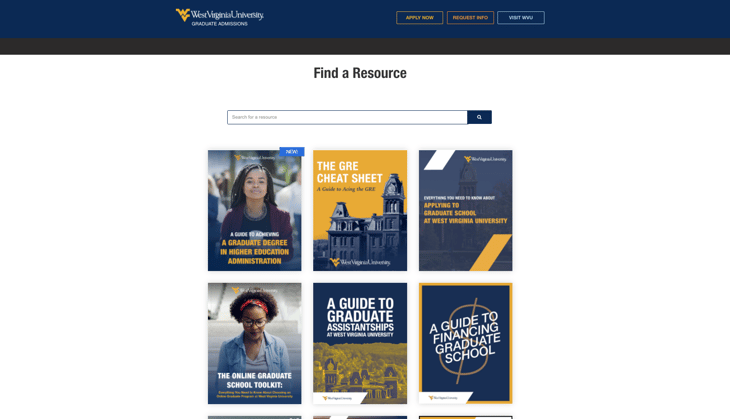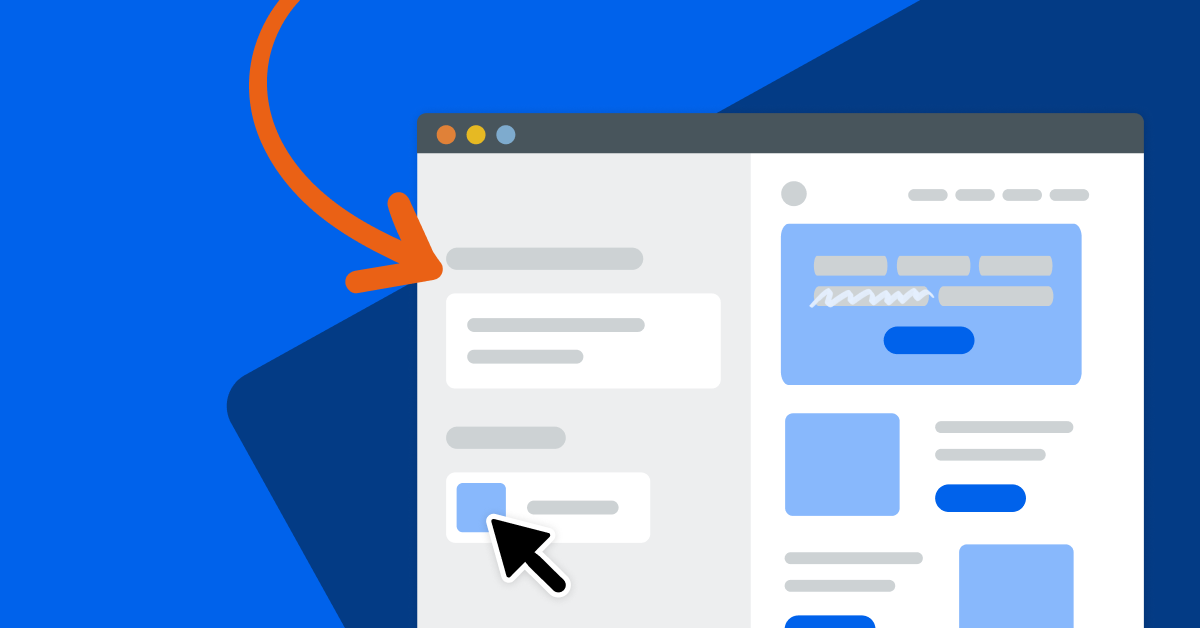How to Write an eBook as Part of your Enrollment Marketing Content Strategy

September 18, 2020

Let’s face it: eBooks are a dime a dozen. There are eBooks about cooking, throwing children’s parties, effectively working from home, budgeting, and more. The list is endless. But when it comes to education marketing, you have a unique opportunity to promote your school or program with an eBook, a type of premium content, that helps nurture prospective students into leads and applicants.
Premium content is long-form, comprehensive and delves into one overarching topic in an effort to attract, engage, and convert your prospective students. It appeals to the pain points and interests of your target audience. An eBook is more than a program guide, a brochure, or a one-pager. It’s a valuable, compelling, educational digital resource that’s gated behind a form, so you can capture prospective student data as part of your enrollment marketing efforts.
Why are eBooks so essential for your content strategy? First, including eBooks in your education marketing plan is a surefire way to build brand awareness, loyalty and thought leadership. The more you can keep prospects engaged with your content, the more likely that your value as a brand goes up from your reader’s perspective.
Second, eBooks are a valuable lead generation tool. A lot of conversion opportunities for schools are action-focused: request more information, RSVP for an info session, apply now, schedule a meeting with an admissions counselor, etc. Ebooks are an excellent secondary content offer that influence prospects who may not be ready to take action yet, but are intrigued enough by your school or program to want to learn more.
An eBook can be an element of an inbound marketing campaign, a strategy built around one offer that involves multiple tactics across multiple channels (email, digital ads, blogs, social media promotions, etc.) You’ll also want to have the following assets:
- A landing page
- A thank you page
- Announcement emails promoting the eBook to current leads and inquiries
- A 'thank you for downloading email' with secondary conversion opportunities
- Relevant blogs that link to the eBook landing page
- Digital ads
But I’m going to focus on the central component of a marketing strategy for student recruitment: how to write an eBook. The eBook serves as the primary content offer at the center of your marketing campaign that engages your readers for the longest amount of time out of all of your marketing assets.
Let’s get into the nuts and bolts first, and then talk about leveling up your eBook game so that you can craft an eBook that is compelling, conversion-centric, and that serves as a centerpiece in your content strategy to increase prospect engagement.
The basics of how to write an eBook:
There are six sequential steps to writing a successful and effective eBook, and each one is vitally important to the process (make sure to follow these steps in order!).
1) Come up with a topic
You need a topic that is helpful, relevant, interesting for prospective students, and wide enough to write a long-form resource about. Brainstorm with your team about common prospect questions or compelling narratives that fit in with your value proposition.
2) Decide on your content strategy
How will you promote your eBook? Do you have a budget for digital advertising? Before even outlining your content, determine the strategy you will use to drive prospects to your premium content.
3) Write an outline
An outline sheds light on your vision for the eBook. It includes a clear purpose (what is the mission of this particular eBook?), keyword research (even for an eBook PDF that doesn’t technically boost your SEO, keywords can be used as power phrases, indicating popular topics and questions prospects have), creative section titles, and sub-points.
4) Write the copy deck
Now it’s time to get to the meat of the eBook! Write each section according to your research, your program knowledge, your experiences chatting with prospects, etc. You may want to tap into your team and ask others to write certain portions of the eBook.
5) Edit the copy deck
Editing your eBook is a key step in building a strong premium content resource. Not only should your eBook be free of grammatical and stylistic errors, the tone should be on-brand and align well with your program. Involve others in the editing process, including faculty members, admissions counselors, and marketing and communications professionals.
6) Send your copy deck to the design desk
Your initial work is complete, and now your content moves on to the design stage. Throughout your copy deck, you should include notes for your designer that explain your vision for graphics, photography or layout to help guide the design process.
How to write an eBook that is compelling:
The best eBooks go beyond factual and functional — they’re creative and compelling. They tell a story. Maybe it’s a story about the application process, about alumni, or about career pathways. Maybe the story is encapsulated in visuals, like images, charts and custom graphics. It could be entirely a narrative account, or a more formal content piece with a few anecdotes sprinkled throughout. One way to include a story is to conduct a Q&A section with a faculty member, a current student, or an alumni.
Prospective students want to see themselves in your content. It’s up to you to hold up that mirror. Student stories that are nestled into a conversion-centric eBook is smart and strategic enrollment marketing.
Write an eBook about a topic that aligns with your audience’s pain points and questions. Your eBook could be about a topic related to your school or program, like career pathways for people who study computer science, or it could be specifically about one program. What will inspire your prospects? What will drive them to action? Always keep the end goal in mind. Remember that marketing copy attracts and converts (this isn’t content just for content’s sake).
You want people who download the eBook to become more interested and prepared for a request for more information form, an application, or a meeting with an admissions counselor.
Whether you’re focusing on a general education topic or a program-specific subject, know your target audience. Persona development is a crucial factor in your content strategy. Ask yourself:
- What do they like?
- What are their questions?
- What are they interested in?
- What types of people do you want in your program? Who is your ideal applicant?
A lot of successful eBooks fill a content void. Some of them, like the University of San Diego’s “Guide to Getting a Teaching Credential” detail a complex process (that eBook has 250 submissions...and counting). Some of them tell stories. ALL of them are interesting to read, or even to skim. Make your content digestible through the use of quote boxes. Call attention to the highlights. Make sure that skimmers see your most important points by making them impossible-to-miss.
In other words, fantastic eBooks delight readers.
If your topic is a little dry, be creative and concise. You can talk about your admissions process in a way that overwhelms and intimidates your audience. Or, you can talk about it in a succinct, clear, innovative fashion. Kent State University’s “Graduate School Decision and Admissions Guide,” for example, includes a fun quiz that gives readers a chance to assess their readiness to pursue a graduate degree.
While applying to school isn’t exactly a trip to the beach, find a way to put your own spin on it or to make it a little more intriguing. Because if you don’t, I guarantee you that someone else will.
How to write an eBook that converts:
To write an eBook that nurtures your prospects further down the funnel, you need well-placed and well-thought out CTAs. Do you want your readers to visit an events page next, or an application page? Make sure you’re abundantly transparent about where you’re inviting your audience to visit next and what they’ll get out of that offer.
You also need a table of contents that aids in navigation and solid section headers that serve as roadmaps for the eBook. And, you need content that prepares prospective students for talking to your admissions team by giving them the necessary information to consider your program. Here is the table of contents page from Vanderbilt University’s cyber-physical systems guide:
One way to make sure your content is conversion-centric is to conduct keyword research and include keyword phrases throughout your copy. While an eBook doesn’t increase your SEO rankings like a pillar page does (a form of premium content that is ungated), keywords can still play a valuable role in the copywriting process. Keywords aren’t just for search bots. Think of them as power phrases that when sprinkled across marketing assets, forge a consistent trail that leads people to the treasure: RMI forms, eBook download forms, event RSVPs (in other words, conversion opportunities).
Using a suite of related keywords and power phrases across your emails, landing pages, ebooks, blog posts, and digital ads:
- builds your brand,
- reinforces your value proposition for your prospects, and
- leaves no room for guesswork about your program/school.
No one ever wonders what Disneyland is all about, right? Everything they create drives home their trademarked slogan, “The Happiest Place on Earth” and motivates people to plan a trip there.
These power phrases tie into your audience’s goals or pain points. For example, if your prospects are interested in topics like artificial intelligence, computer science, and computer programming, then articulating 5-10 phrases that lend credence to why their interests align with your program is paramount.
Another way to write an eBook that converts is to pay special attention to design. Include notes for your designers in your copy deck that explain your vision to help ensure that the eBook design is as enticing and engaging as the material is. The worst situation is when an eBook copy is rich and enjoyable but the design is atrocious, or on the other hand, when the design is beautiful but the copy is a snooze. That makes it less likely that prospects will want to keep scrolling or click on your CTAs.
Like Batman and Robin, content and design work together to create a high-quality premium content piece that drives prospects to action.
How to write an eBook that increases prospect engagement and generates more conversions:
A great eBook topic feeds into other topics. There should be related blog posts and even other eBooks that are all intertwined into the glorious web that is an inbound marketing content foundation. Think about the sections of your eBooks — maybe they would lend themselves well to blog posts. Or consider the spin-off questions someone might have after reading an eBook. What if they read about your program in one eBook and then they’re ready to apply? Offer an admissions eBook that explains the application process.
Identify which stage of the funnel your eBook fits into — not only will it affect how you write the ebook, but it will also inform how you promote it. The applicant journey has three stages: awareness, consideration and decision. This is not a linear pathway, and an effective content strategy involves multiple content pieces across all stages that link to each other. That way, prospects can determine the offers that make the most sense to them, as they jump back and forth through the journey stages.
Over time, your eBooks can become a rich, informative, comprehensive resource library. West Virginia University has 13 graduate school eBooks in its library, with titles ranging from “The GRE Cheat Sheet: A Guide to Acing the GRE” to “A Guide to Graduate Assistantships at West Virginia University” to “The Online Graduate School Toolkit: Everything You Need to Know About Choosing an Online Graduate Program at West Virginia University.”

If you use HubSpot’s Topic Cluster tool, an eBook topic can be at the center of a diagram that shows how various content pieces are related to each other. The content piece is the comprehensive resource about the topic, while supporting pieces link back to the eBook with the same keyword phrases. Regardless of the tool that you use, to maximize the value of your eBook, make sure to leverage it across content assets, including blogs, landing pages, digital ads and emails.
Writing an eBook that is compelling, conversion-centric, and a focal point of your content strategy isn’t an easy task. But you’ll find that it’s well worth your time and effort as a tactic for generating leads, increasing thought leadership, and driving prospects down the funnel to become enrolled students.
Ready to craft a custom content strategy?
We’ll help you create a content plan that really works! Learn more about our 8-week Content Strategy for Graduate Enrollment Marketing Cohort and sign up to start ironing out a foolproof content foundation.
Save your spot today for the Content Strategy Cohort to take you from 0 to 60 in just eight weeks!
.jpg) EBOOK
EBOOK
See how schools are using HubSpot for their enrollment marketing
Service Categories: Enrollment Marketing, Inbound Marketing, Content Strategy, Creative & Content






.png)


.png)